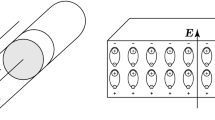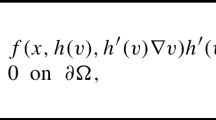Abstract
In this paper, we study some techniques for solving numerically magnetostatic systems. We consider fairly general assumptions on the magnetic permeability tensor. It is elliptic, but can be nonhermitian. In particular, we revisit existing classical variational methods and propose new numerical methods. The numerical approximation is either based on the classical edge finite elements or on continuous Lagrange finite elements. For the first type of discretization, we rely on the design of a new, mixed variational formulation that is obtained with the help of T-coercivity. The numerical method can be related to a perturbed approach for solving mixed problems in electromagnetism. For the second type of discretization, we rely on an augmented variational formulation obtained with the help of the weighted regularization method.
Similar content being viewed by others
Data availability
Data are available on request from authors.
References
Alonso Rodriguez, A., Bertolazzi, E., Valli, A.: The curl–div system: theory and finite element approximation. Maxwell’s equations-analysis and numerics. Radon Ser. Comput. Appl. Math., vol. 24, pp. 1–43. De Gruyter, Berlin, Germany (2019)
Ciarlet Jr., P.: T-coercivity: application to the discretization of Helmholtz-like problems. Comput. Math. Applic. 64, 22–34 (2012)
Chesnel, L., Ciarlet Jr., P.: T-coercivity and continuous Galerkin methods: application to transmission problems with sign changing coefficients. Numer. Math. 124, 1–29 (2013)
Nédélec, J.-C.: Mixed finite elements in \(\mathbb{R} ^3\). Numer Math. 35, 315–341 (1980)
Monk, P.: Finite element methods for Maxwell’s equations. Oxford University Press, Oxford, Great Britain (2003)
Costabel, M., Dauge, M.: Weighted regularization of Maxwell’s equations in polyhedral domains. SIAM J. Numer. Anal. 93, 239–277 (2002)
Kirsch, A., Hettlich, F.: Mathematical theory of time-harmonic Maxwell’s equations. Springer, Cham, Switzerland (2016)
Assous, F., Ciarlet Jr., P., Labrunie, S.: Mathematical foundations of computational electromagnetism. Springer, Cham, Switzerland (2018)
Gross, P.W., Kotiuga, P.R.: Electromagnetic theory and computation: a topological approach. MSRI Publications Series, 48. Cambridge University Press, Cambridge (2004)
Bossavit, A.: Computational electromagnetism. Academic Press, New York, USA (1998)
Bermúdez, A., Gómez, D., Salgado, P.: Mathematical models and numerical simulation in electromagnetism. Springer, Cham, Switzerland (2014)
Bermúdez, A., Rodriguez, R., Salgado, P.: A finite element method for the magnetostatic problem in terms of scalar potentials. SIAM J. Numer. Anal. 46, 1338–1363 (2008)
Bermúdez, A., López-Rodriguez, B., Rodriguez, R., Salgado, P.: Equivalence between two finite element methods for the eddy current problem. C. R. Acad. Sci. Paris, Ser. I. 348, 769–774 (2010)
Tang, Z., Le Menach, Y., Creusé, E., Nicaise, S., Piriou, F., Nemitz, N.: Residual and equilibrated error estimators for magnetostatic problems solved by finite element method. IEEE Trans. Magn. 49, 5715–5723 (2013)
Bermúdez, A., Piñiero, M., Rodriguez, R., Salgado, P.: Analysis of an ungauged \(T,{\phi }-{\phi }\) formulation of the eddy current problem with currents and voltage excitations. Math. Mod. Num. Anal. 51, 2487–2509 (2017)
Bermúdez, A., Piñiero, M., Salgado, P.: Mathematical and numerical analysis of a transient magnetic model with voltage drop excitations. Computers Math. Applic. 76, 2710–2722 (2018)
Creusé, E., Dular, P., Nicaise, S.: About the gauge conditions arising in finite element magnetostatic problems. 77, 1563–1582 (2019)
Chicaud, D., Ciarlet Jr., P., Modave, A.: Analysis of variational formulations and low-regularity solutions for time-harmonic electromagnetic problems in complex anisotropic media. SIAM J. Math. Anal. 53, 2691–2717 (2021)
Chicaud, D., Ciarlet Jr., P.: Analysis of time-harmonic Maxwell impedance problems in anisotropic media. SIAM J. Math. Anal. 55, 1969–2000 (2023)
Feistauer, M., Ženišek, A.: Finite element solution of nonlinear elliptic problems. Numer. Math. 50, 451–475 (1987)
Dello Russo, A., Alonso, A.: Finite element approximation of Maxwell eigenproblems on curved Lipschitz polyhedral domains. Appl. Numer. Math. 59, 1796–1822 (2009)
Bramble, J.H., Pasciak, J.E.: A new approximation technique for div-curl systems. Math. Comp. 73, 1739–1762 (2003)
Duan, H., Jia, F., Lin, P., Tan, R.C.E.: The local \(L^2\) projected \(C^0\) finite element method for Maxwell problem. SIAM J. Numer. Anal. 47, 1274–1303 (2009)
Bonito, A., Guermond, J.-L.: Approximation of the eigenvalue problem for the time harmonic Maxwell system by continuous Lagrange finite elements. Math. Comp. 80, 1887–1910 (2011)
Badia, S., Codina, R.: A nodal-based finite element approximation of the Maxwell problem suitable for singular solutions. SIAM J. Numer. Anal. 50, 398–417 (2012)
Duan, H., Du, Z., Liu, W., Zhang, S.: New mixed element for Maxwell equations. SIAM J. Numer. Anal. 57, 320–354 (2019)
Ern, A., Guermond, J.-L.: Finite elements II. Springer, Cham, Switzerland (2021)
Jamelot, E., Ciarlet Jr., P.: Fast non-overlapping Schwarz domain decomposition methods for solving the neutron diffusion equation. J. Comput. Phys. 241, 445–463 (2013)
Ciarlet Jr., P., Jamelot, E., Kpadonou, F.D.: Domain decomposition methods for the diffusion equation with low-regularity solution. Comput. Math. Applic. 74, 2369–2384 (2017)
Giret, L.: Non-conforming domain decomposition for the multigroup neutron SPN equation. PhD thesis, Université Paris-Saclay (2018)
Barré, M., Ciarlet Jr., P.: The T-coercivity approach for mixed problems to appear in C. R. Acad. Sci. Paris, Ser. I
Jamelot, E.: Improved stability estimates for solving Stokes problem with Fortin-Soulie finite elements. Technical Report HAL (2023)
Ciarlet Jr., P.: Lecture notes on Maxwell’s equations and their approximation (in French). Master’s degree analysis, modelling and simulation from paris-saclay university and institut polytechnique de paris (2022). https://hal.inria.fr/hal-03153780v3
Weber, C.: A local compactness theorem for Maxwell’s equations. Math. Meth. Appl. Sci. 2, 12–25 (1980)
Reitzinger, S., Schöberl, J.: An algebraic multigrid method for finite element discretizations with edge elements. Numer. Linear Algebra Appl. 9, 223–238 (2002)
Duan, H., Li, S., Tan, R.C.E., Zheng, W.: A delta-regularization finite element method for a double curl problem with divergence-free constraint. SIAM J. Numer. Anal. 50, 3208–3230 (2012)
Ciarlet Jr., P., Wu, H., Zou, J.: Edge element methods for Maxwell’s equations with strong convergence for Gauss’ laws. SIAM J. Numer. Anal. 52, 779–807 (2014)
Bermúdez, A., Rodriguez, R., Salgado, P.: Numerical treatment of realistic boundary conditions for the eddy current problem in an electrode via Lagrange multipliers. Math. Comp. 74, 123–151 (2005)
Raviart, P.-A., Thomas, J.-M.: A mixed finite element method for second order elliptic problems. In: Mathematical aspects of finite element methods. Lecture notes in mathematics, vol. 606, pp. 292–315. Springer, Berlin, Germany (1977)
Bermudez, A., Gamallo, P., Nogueiras, M.R., Rodriguez, R.: Approximation of a structural acoustic vibration problem by hexahedral finite elements. IMA J. Numer. Anal. 26, 391–421 (2006)
Jerison, D.S., Kenig, C.E.: The Neumann problem on Lipschitz domains. Bull. Amer. Math. Soc. 4, 203–207 (1981)
Grisvard, P.: Elliptic problems in nonsmooth domains. Pitman, Boston, London, Melbourne (1985)
Dauge, M.: Elliptic boundary value problems on corner domains. Springer, Berlin, Germany (1988)
Birman, M.S., Solomyak, M.Z.: Maxwell operator in regions with nonsmooth boundaries. Sib. Math. J. 28, 12–24 (1987)
Hiptmair, R.: Finite elements in computational electromagnetics. Acta Numerica. 50, 237–339 (2002)
Costabel, M., Dauge, M., Nicaise, S.: Singularities of Maxwell interface problems. Modél. Math. Anal. Numér. 33, 627–649 (1999)
Ciarlet Jr., P.: On the approximation of electromagnetic fields by edge finite elements. Part 1: sharp interpolation results for low-regularity fields. Computers Math. Applic. 71, 85–104 (2016)
Costabel, M., Dauge, M., Nicaise, S.: Corner singularities and analytic regularity for linear elliptic systems. Part I: Smooth domains (2010). https://hal.archives-ouvertes.fr/hal-00453934v2
Bonito, A., Guermond, J.-L., Luddens, F.: Regularity of the Maxwell equations in heterogeneous media and Lipschitz domains. J. Math. Anal. Appl. 408, 498–512 (2013)
Ciarlet Jr., P.: Augmented formulations for solving Maxwell equations. Comp. Meth. Appl. Mech. and Eng. 194, 559–586 (2005)
Jamelot, E.: Continuous Galerkin methods for solving Maxwell equations (in French). PhD thesis, Ecole Polytechnique (2005)
Ciarlet Jr., P., Jamelot, E.: Continuous Galerkin methods for solving the time-dependent Maxwell equations in 3D geometries. J. Comput. Phys. 226, 1122–1135 (2007)
Buffa, A., Ciarlet Jr., P., Jamelot, E.: Solving electromagnetic eigenvalue problems in polyhedral domains. Numer. Math. 113, 497–518 (2009)
Ciarlet Jr., P., Labrunie, S.: Numerical analysis of the generalized Maxwell equations (with an elliptic correction) for charged particle simulations. Math. Models Meth. App. Sci. 19, 1959–1994 (2009)
Ciarlet Jr., P., Scheid, C.: Electrowetting of a 3D drop: numerical modelling with electrostatic vector fields. Math. Mod. Num. Anal. 44, 647–670 (2010)
Otin, R.: Regularized Maxwell equations and nodal finite elements for electromagnetic field computations. Electromagnetics. 30, 190–204 (2010)
Costabel, M.: A coercive bilinear form for Maxwell’s equations. J. Math. Anal. and Appl. 157, 527–541 (1991)
Costabel, M., Dauge, M.: Singularities of electromagnetic fields in polyhedral domains. Arch. Rational Mech. Anal. 151, 221–276 (2000)
Clough, R.W., Tocher, J.L.: Finite element stiffness matrices for analysis of plates in bending. In: Conference on matrix methods in structural mechanics, Wright Patterson A.F.B, Dayton, USA, pp. 515–545 (1965)
Ciarlet, P.G.: Basic error estimates for elliptic problems. Handbook of numerical analysis, vol. II, pp. 17–351. North Holland, Amsterdam, The Netherlands (1991)
Percell, P.: On cubic and quartic Clough-Tocher finite elements. SIAM J. Numer. Anal. 13, 100–103 (1976)
Alfeld, P.: A trivariate Clough-Tocher scheme for tetrahedral data. Comput. Aided Geom. Design. 1, 169–181 (1984)
Sorokina, T., Worsey, A.J.: A multivariate Powell-Sabin interpolant. Adv Comput Math. 29, 71–89 (2008)
Badia, S., Codina, R.: A combined nodal continuous-discontinuous finite element formulation for the Maxwell problem. Appl. Math. Comput. 218, 4276–4294 (2011)
Eddargani, S.: Approximation by splines functions on Powell-Sabin triangulations. PhD thesis, Universidad de Granada and Université Hassan 1er (2021)
Otin, R.: Regularized Maxwell equations and nodal finite elements for electromagnetic field computations in frequency domain. PhD thesis, Polytechnic University of Catalonia (2011)
Otin, R.: ERMES:a nodal-based finite element code for electromagnetic simulations in frequency domain. Comput. Phys. Commun. 184, 2588–2595 (2013)
Author information
Authors and Affiliations
Corresponding author
Ethics declarations
Conflict of interest
The authors declare no competing interests.
Additional information
Communicated by: Francesca Rapetti
This article is dedicated to Professor Alain Bossavit on the occasion of his 80th birthday.
Publisher's Note
Springer Nature remains neutral with regard to jurisdictional claims in published maps and institutional affiliations.
Rights and permissions
Springer Nature or its licensor (e.g. a society or other partner) holds exclusive rights to this article under a publishing agreement with the author(s) or other rightsholder(s); author self-archiving of the accepted manuscript version of this article is solely governed by the terms of such publishing agreement and applicable law.
About this article
Cite this article
Ciarlet Jr., P., Jamelot, E. Variational methods for solving numerically magnetostatic systems. Adv Comput Math 50, 5 (2024). https://doi.org/10.1007/s10444-023-10089-1
Received:
Accepted:
Published:
DOI: https://doi.org/10.1007/s10444-023-10089-1




